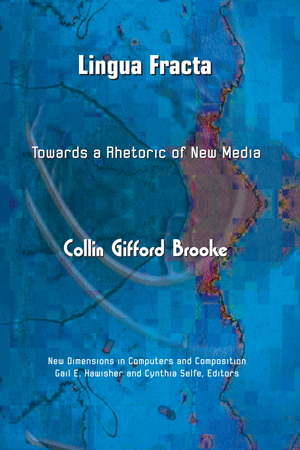Brooke, Collin Gifford. Lingua Fracta: Towards a Rhetoric of New Media.
Cresskill, NJ: Hampton P, 2009. 222 pp, ISBN 9781572738935
Reviewed by Kerri Hauman, Bowling Green State University
INTRO CHAPTERS 1-2 CHAPTERS 3-5 CHAPTERS 6-8 CONCLUSIONS

CHAPTERS 3-5 |
|
Having established his reasoning for treating the canons as an ecology of practice through which we can examine new media, in Chapter 3, Brooke introduces the term “Proairesis” as a way to help us rethink and expand our understanding of Invention. He borrows this word from Roland Barthes’ ideas about hermeneutic and proairetic codes. Brooke argues that we need to acknowledge and correct our tendency, in hermeneutic invention, toward closure, toward getting to the “right” answer. Without arguing that we should never aim for closure in textual objects, he maintains that proairetic invention, with its emphasis on generating possibilities rather than arriving at finite conclusions, offers us an important corrective when working with new media, which themselves resist closure. Brooke’s claims in Chapter 4 – “Pattern,” which is the new term for Arrangement – draw again on Bolter as well as on Lev Manovich. Brooke draws on Bolter in order to support his argument that new media require us to reconceptualize “arrangement as sequence” as “arrangement as pattern.” He also challenges Manovich’s contention that narrative and database are oppositional; Brooke believes they are not separate but, instead, mediated. At the end of this chapter, Brooke begins a trend he continues to use throughout the rest of the book: using specific computer sites/applications to demonstrate his claims. Here, he uses tagclouds and the database (in particular websites like Amazon, flickr, and delicious) to illustrate his belief that arrangement can be reconceived of as a practice that mediates the categories of narrative and database. In Chapter 5, Brooke introduces the term “Perspective” as an alternative to Style. He begins by arguing that recent attempts to establish ways for looking at new media rely on print-based language and approaches, which are not appropriate for visual rhetoric. As we attempt to create new practices for thinking about style and new media, he cautions us to resist the tendency to create terminology that lumps too much together.
|